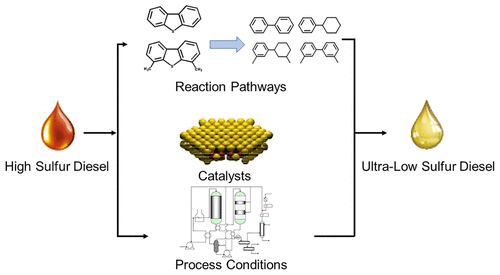当前位置:
X-MOL 学术
›
Ind. Eng. Chem. Res.
›
论文详情
Our official English website, www.x-mol.net, welcomes your
feedback! (Note: you will need to create a separate account there.)
Ultradeep Hydrodesulfurization of Diesel: Mechanisms, Catalyst Design Strategies, and Challenges
Industrial & Engineering Chemistry Research ( IF 3.8 ) Pub Date : 2020-11-27 , DOI: 10.1021/acs.iecr.0c04049 Xiaoyi Weng 1 , Liyuan Cao 1 , Guohao Zhang 1 , Feng Chen 1 , Liang Zhao 1 , Yuhao Zhang 1 , Jinsen Gao 1 , Chunming Xu 1
Industrial & Engineering Chemistry Research ( IF 3.8 ) Pub Date : 2020-11-27 , DOI: 10.1021/acs.iecr.0c04049 Xiaoyi Weng 1 , Liyuan Cao 1 , Guohao Zhang 1 , Feng Chen 1 , Liang Zhao 1 , Yuhao Zhang 1 , Jinsen Gao 1 , Chunming Xu 1
Affiliation

|
With the increasingly strict diesel standards in the countries of the world, deep processing of diesel oil to ultralow sulfur levels is receiving more and more attention. This paper mainly reviews the reaction mechanism, catalysts, and process conditions of diesel hydrodesulfurization, and it provides new research directions for producing ultralow sulfur diesel (ULSD). In terms of mechanism, the sterically hindered sulfides, nitrides, aromatic compounds, and hydrogen sulfide affect the direct desulfurization and hydrogenate pathways of the hydrodesulfurization reaction to varying degrees. In order to eliminate these effects, the properties of high-dispersion active metals, large pore size, high specific surface area, high content of medium-weak acid, and a certain amount of Bronsted acid support are beneficial to further improve the activity of the catalyst, to produce ULSD that meets market demand. This article also reviews the influences of process conditions (for instance, temperature, hydrogen pressure, liquid hourly space velocity, and hydrogen consumption) on the diesel ultradeep hydrodesulfurization reaction, and it finds those moderately high temperatures and high hydrogen partial pressures, as well as low space velocity, to be beneficial. In short, the development of new catalysts is the current research hotspot in the field of ultradeep hydrodesulfurization of diesel, and further research is still needed.
中文翻译:

柴油超深度加氢脱硫:机理,催化剂设计策略和挑战
随着世界各国对柴油标准的日益严格,将柴油深加工至超低硫水平越来越受到关注。本文主要综述了柴油加氢脱硫的反应机理,催化剂和工艺条件,为生产超低硫柴油(ULSD)提供了新的研究方向。就机理而言,位阻硫化物,氮化物,芳族化合物和硫化氢在不同程度上影响加氢脱硫反应的直接脱硫和氢化途径。为了消除这些影响,高分散活性金属的特性,大孔径,高比表面积,中弱酸含量高,以及一定量的布朗斯台德酸载体有利于进一步提高催化剂的活性,生产出满足市场需求的超低硫柴油。本文还回顾了工艺条件(例如温度,氢气压力,液体时空速度和氢气消耗)对柴油超深度加氢脱硫反应的影响,并发现了适度的高温和较高的氢气分压,以及低空速,是有益的。简而言之,新型催化剂的开发是柴油超深度加氢脱硫领域的当前研究热点,并且仍需要进一步的研究。液体时空速和氢消耗)在柴油超深度加氢脱硫反应中的作用,发现适度的高温和高的氢分压以及低的空速是有益的。简而言之,新型催化剂的开发是柴油超深度加氢脱硫领域的当前研究热点,并且仍需要进一步的研究。液体时空速和氢消耗)在柴油超深度加氢脱硫反应中的作用,发现适度的高温和高的氢分压以及低的空速是有益的。简而言之,新型催化剂的开发是柴油超深度加氢脱硫领域的当前研究热点,并且仍需要进一步的研究。
更新日期:2020-12-09
中文翻译:

柴油超深度加氢脱硫:机理,催化剂设计策略和挑战
随着世界各国对柴油标准的日益严格,将柴油深加工至超低硫水平越来越受到关注。本文主要综述了柴油加氢脱硫的反应机理,催化剂和工艺条件,为生产超低硫柴油(ULSD)提供了新的研究方向。就机理而言,位阻硫化物,氮化物,芳族化合物和硫化氢在不同程度上影响加氢脱硫反应的直接脱硫和氢化途径。为了消除这些影响,高分散活性金属的特性,大孔径,高比表面积,中弱酸含量高,以及一定量的布朗斯台德酸载体有利于进一步提高催化剂的活性,生产出满足市场需求的超低硫柴油。本文还回顾了工艺条件(例如温度,氢气压力,液体时空速度和氢气消耗)对柴油超深度加氢脱硫反应的影响,并发现了适度的高温和较高的氢气分压,以及低空速,是有益的。简而言之,新型催化剂的开发是柴油超深度加氢脱硫领域的当前研究热点,并且仍需要进一步的研究。液体时空速和氢消耗)在柴油超深度加氢脱硫反应中的作用,发现适度的高温和高的氢分压以及低的空速是有益的。简而言之,新型催化剂的开发是柴油超深度加氢脱硫领域的当前研究热点,并且仍需要进一步的研究。液体时空速和氢消耗)在柴油超深度加氢脱硫反应中的作用,发现适度的高温和高的氢分压以及低的空速是有益的。简而言之,新型催化剂的开发是柴油超深度加氢脱硫领域的当前研究热点,并且仍需要进一步的研究。





















































 京公网安备 11010802027423号
京公网安备 11010802027423号